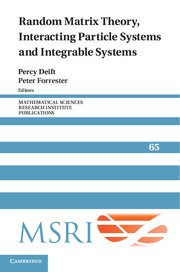Book contents
- Frontmatter
- Contents
- Preface
- Universality conjecture for all Airy, sine and Bessel kernels in the complex plane
- On a relationship between high rank cases and rank one cases of Hermitian random matrix models with external
- Riemann–Hilbert approach to the six-vertex model
- CLT for spectra of submatrices of Wigner random matrices, II: Stochastic evolution
- Critical asymptotic behavior for the Korteweg–de Vries equation and in random matrix theory
- On the asymptotics of a Toeplitz determinant with singularities
- Asymptotic analysis of the two-matrix model with a quartic potential
- Conservation laws of random matrix theory
- Asymptotics of spacing distributions 50 years later
- Applications of random matrix theory for sensor array imaging with measurement noise
- Convolution symmetries of integrable hierarchies, matrix models and τ-functions
- Universality limits via “old style” analysis
- Fluctuations and large deviations of some perturbed random matrices
- Three lectures on free probability
- Whittaker functions and relatedstochastic processes
- How long does it take to compute the eigenvalues of a random symmetric matrix?
- Exact solutions of the Kardar–Parisi–Zhang equation and weak universality for directed random polymers
- Replica analysis of the one-dimensional KPZ equation
- Asymptotic expansions for β matrix models and their applications to the universality conjecture
- KPZ scaling theory and the semidiscrete directed polymer model
- Experimental Realization Of Tracy–Widom Distributions And Beyond: Kpz Interfaces In Turbulent Liquid Crystal
- Random matrices: the four-moment theorem for Wigner ensembles
Fluctuations and large deviations of some perturbed random matrices
Published online by Cambridge University Press: 29 May 2025
- Frontmatter
- Contents
- Preface
- Universality conjecture for all Airy, sine and Bessel kernels in the complex plane
- On a relationship between high rank cases and rank one cases of Hermitian random matrix models with external
- Riemann–Hilbert approach to the six-vertex model
- CLT for spectra of submatrices of Wigner random matrices, II: Stochastic evolution
- Critical asymptotic behavior for the Korteweg–de Vries equation and in random matrix theory
- On the asymptotics of a Toeplitz determinant with singularities
- Asymptotic analysis of the two-matrix model with a quartic potential
- Conservation laws of random matrix theory
- Asymptotics of spacing distributions 50 years later
- Applications of random matrix theory for sensor array imaging with measurement noise
- Convolution symmetries of integrable hierarchies, matrix models and τ-functions
- Universality limits via “old style” analysis
- Fluctuations and large deviations of some perturbed random matrices
- Three lectures on free probability
- Whittaker functions and relatedstochastic processes
- How long does it take to compute the eigenvalues of a random symmetric matrix?
- Exact solutions of the Kardar–Parisi–Zhang equation and weak universality for directed random polymers
- Replica analysis of the one-dimensional KPZ equation
- Asymptotic expansions for β matrix models and their applications to the universality conjecture
- KPZ scaling theory and the semidiscrete directed polymer model
- Experimental Realization Of Tracy–Widom Distributions And Beyond: Kpz Interfaces In Turbulent Liquid Crystal
- Random matrices: the four-moment theorem for Wigner ensembles
Summary
We review joint results with Benaych-Georges and Guionnet (Electron. J. Probab. 16:60 (2011), 1621–1662 and Prob. Theory Rel. Fields 154:3–4 (2012), 703–751) about fluctuations and large deviations of some spiked models, putting them in the perspective of various works of the last years on extreme eigenvalues of finite-rank deformations of random matrices.
1.Introduction
General statement of the problem. The following algebraic problem is very classical: ,Let A and B be two Hermitian matrices of the same size. Assume we know the spectrum of each of them. What can be said about the spectrum of their sum A + B? The problem was posed by Weyl [1912]. He gave a series of necessary conditions, known as Weyl's interlacing inequalities: if λ1(A)≥...≥ λn(A), λ1(B)≥...≥ λn(B) and λ1(A + B) ≥...≥λn(A + B) are the spectra of A, B and A + B, then
whenever 0≤i; j; i + j <n. These inequalities have been very fruitful in various fields.
After that, it took a long time to get necessary and sufficient conditions. Horn in the sixties formulated the right conjecture, but the final answer was only given in the late nineties in a series a papers [Klyachko 1998; Helmke and Rosenthal 1995; Knutson and Tao 2001].
If we now look at the problem asymptotically, namely when the size of both matrices goes to infinity, an important breakthrough was made by free probability theory with the notion of asymptotic freeness. This property can be roughly stated as follows: If A and B are large-dimensional and in generic position relative to one another, the limiting spectrum of their sum depends only on their respective spectra and is given by the free convolution of the two spectra. We won't go
further into free probability theory, but we refer the reader to [Emery et al. 2000] for general background on free probability.
Information
- Type
- Chapter
- Information
- Publisher: Cambridge University PressPrint publication year: 2014
